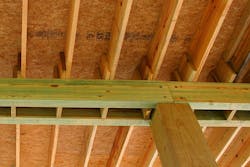A bold new initiative from APA’s Designers Circle program, Compelling Conversations features thought-leading architects talking with an APA expert about real issues they and their colleagues face when working with engineered wood in commercial applications. For this first installment, APA engineered wood specialist Karyn Beebe sits down with Greg Mella, an award-winning architect with SmithGroupJJR in Washington, D.C., to discuss the merits of wood and debate its use in coastal applications.
Karyn Beebe: Greg, I understand that you were an early adopter of engineered wood products at a time when there weren’t a lot of commercial office buildings using wood structural framing in the late ’90s. Why did you break from the pack?
Greg Mella: At the time, there weren’t a lot of commercial office buildings that were using wood. A lot of what we were looking at then – this is 1998, 1999 – were technologies that were used in residential markets. But we found that bringing some of these residential technologies to a commercial setting gave us this opportunity to create a more sustainable building.
At the same time, we didn’t want to use large old growth trees. We wanted to minimize the habitat impact of materiality. So we went with parallel strand lumber because it was using scraps and portions of the log that ordinarily would have been wasted. We wound up selecting SIPs (structural insulated panels) because of the material efficiency. They use a lot less material resources to create a skin but offer incredible thermal performance. We were also looking at a wall assembly that was an R-24 and a roof assembly that was an R-30. Today that’s actually timid performance, or at best slightly better than code. But at the time, it was revolutionary to achieve those kinds of R-levels.
We also looked at statistics at the time that suggested that a wood beam had about a tenth the embodied energy of a steel beam or a concrete beam. Embodied energy is the amount of energy it takes to extract, manufacture and transport a product to a construction site. And that was a big factor in the selection of wood.
Karyn: Any other reasons why wood was a fit?
Greg: There are lots of rational reasons that led us to wood. But then there was also just the beauty; it feels like you’re connected to nature. Similarly, we wanted products that had what we call biophilic benefit. This is the understanding that humankind responds best in settings where they feel some kind of connection to nature. These kinds of goals really led us to selecting wood as the primary structural product for the job.
Karyn: I love the fact that you worked biophilia into the conversation. I think biophilia will become more and more important. Studies at hospitals and schools have shown that people get healthier, perform better, and can stay better focused in a natural environment and buildings constructed with natural materials.
And yet you had reservations about using wood for the Brock Environmental Center. I’m curious what your concerns were.
Greg: We did consider wood, but Brock is in a hurricane zone on a site that is subject to periodic flooding. The building sits about 10 feet above grade. And then it’s in a more coastal setting. So there’s more salt spray in the air. That can lead to corrosion. To come up with a structural system for Brock that would have met all of these criteria, it would have been a lot beefier.
And we had an aesthetic goal for Brock. We wanted it to kind of mimic a crane or egret where you have a substantial body of the bird sitting on very thin legs that kind of wade above the water. It was a biophilic goal of the overall design. So for these reasons, we leaned more toward a steel structural system.
That said, once we made the decision on what the skeleton of the building would be, we still looked for opportunities to include wood. For example, we used 2x6 framing in lieu of cold-frame metal studs, which might have been cheaper. Not necessarily though. I think architects just default toward metal studs, especially for exterior walls. And it just doesn’t make a lot of sense. I mean, the wood stud has a lower embodied energy. It also has a lot better thermal properties, so you’re getting a higher R-value in your wall assembly by going with the wood studs in lieu of a steel stud.
But no one material is perfect for everything, right?
Karyn: Right. Still, there are good wood alternatives for coastal environments like Brock when the wood is exposed beyond the construction phase. On the West Coast we commonly see southern yellow pine treated glulam beams, which don’t require incising (penetrations made on the members to aid in the penetration of the preservative treatment). That’s nice when you’re looking at aesthetics. The other alternative would be something that’s naturally decay resistant, so perhaps an Alaskan yellow cedar or a Port Orford cedar could have been used and perhaps fit the bill for you with the flooding and corrosion concerns. Of course wood members that are enclosed by the building finishes (wall cladding, roofing, and flooring materials) do not need to be treated.
When it comes to high wind concerns, APA’s SR-101 System Report was designed for combined shear and uplift for wind, specifically. And that’s recently been updated now for the 2015, ’12 and ’09 IBC. That’s a design method that your structural engineer can incorporate so that you can use wood structural panels if you were going to use a shear wall system for your lateral resistance, not only to resist the racking force on the building, but also the uplift that needs to be accommodated. So it’s a nice thing to realize, when you are building in high wind zones, how to maximize the material you have.
Greg: Great. But the greenest material is the one you don’t use. I absolutely try to take that credo with me wherever I go.
Karyn: So true, Greg. And you mentioned your project was net positive energy. That’s amazing. You know, one of the things the EPA has done recently to assist in this is to refocus on advanced framing techniques. Have you used those principles on any of your projects? That can really help maximize your energy efficiency.
Greg: I think I’m loosely familiar with it, but I probably couldn’t cite anything too specific.
Karyn: Advanced framing has its roots in residential construction. And it comes back to really the structure itself. So instead of a 2x4 at 16 inches on center framing system, you would go with a 2x6 at 24 inches on center. And it’s really about maximizing the ability of what you can insulate within the cavity of the wall.
You can also redesign your headers so that they can be insulated as opposed to taking a 4-inch wall and filling it with a 4-inch header. If you are using wood structural panels as your shear wall system, you can design those as headers. We have wood structural panel box beam header design guidance, as one sided or two sided.
So there are lots of simple things that can be implemented, particularly for your structural engineer. Structural engineers often have a standard header table on their plans and I recommend they create an insulated header table that can be used to get some additional sustainability and energy savings into that structure. I’d recommend you guys take a look at our Advanced Framing guide next time around so that you can see if there’s anything you’re missing. We also have the CAD details available on our website so you don’t have to recreate the wheel, and you can download them for yourself.
Greg: Now that’s the kind of recycling I like. That’s great.
Karyn: And you know, our job is to help people maybe take a second look at what they did on their last project, so that we can update it with the newest technology and help take advantage of what’s available.
Greg: That’s perfect. The worst answer to the question, “Why did you use that material?” is, “I used it on my last job.” That’s so unimaginative and unspecific. So you’ve kind of helped us cross that barrier with this conversation.
It was especially interesting that advanced framing came out of the residential market. That parallels what I was saying about Merrill and how green buildings in the U.S. really came out of the residential market. We can learn a lot from the way things are mass-produced. There’s a great environmental benefit in innovation when you apply that kind of thinking to commercial buildings.
Karyn: Absolutely.
Greg Mella was thinking green before much of our society thought about sustainability or even heard of the U.S. Green Building Council's Leadership in Energy and Environmental Design (LEED) rating system. He brings an in-depth knowledge of environmentally intelligent building materials and practices to every project, and uses a “whole building" systems-oriented approach that examines how to integrate architecture with the mechanical, electrical, and plumbing systems to maximize shared benefits. Greg's design of the Chesapeake Bay Foundation's Merrill Center, the world's first LEED Platinum Building, created a benchmark on sustainability.
About the Author

Karyn Beebe
Karyn Beebe, PE, LEED AP is an Engineered Wood Specialist for APA-The Engineered Wood Association. Her duties include consulting with designers on the efficient specification of engineered wood products in construction. A licensed Professional Engineer in the state of California, Beebe graduated from Purdue University with a BS in Civil Engineering. She is an active member of the Structural Engineers Association and the U.S. Green Building Council, and serves as President for the San Diego Area Chapter of the ICC. Prior to joining APA, Beebe worked as a structural engineer and structural plan reviewer for the San Diego building department.
